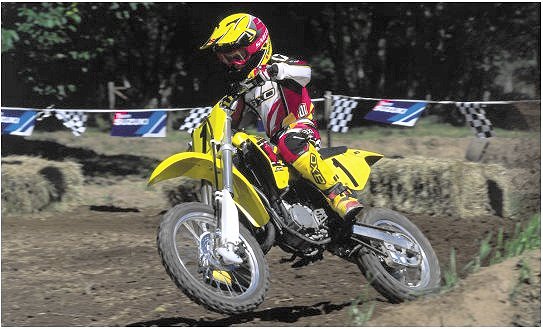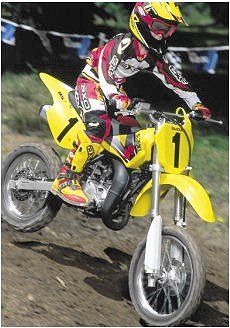
Suzuki has long been known for making an 80cc-class motocrosser with the most flexible engine in the class. Decent low-end and mid-range, in a class traditionally dominated by engines with shrieking top-end power bands, and virtually nothing else. As a result, the Suzuki could serve as a casual trail/play bike, in addition to a racer (it is always easier to make a torquey bike into a screamer, than the other way around).
Well, 80cc bikes began turning into 85cc bikes on the showroom floor when Kawasaki introduced its KX85 a few years ago. Suzuki followed suit in 2002 with the RM85, and didn’t stop at an engine capacity change. Featuring many technical engine and chassis upgrades — the most visible of which are new plastic and new upside-down forks, Suzuki essentially designed and built a ground-up restoration of its long-unchanged 80cc machine.
After an extended test of the new 2002 RM85 (with 12 year old Evan Edge the primary rider), MD came away extremely impressed. Most notable, is the shockingly torquey nature of the new engine — exerting more low-end power and torque than any other 80cc-class machine we have ever sampled, or heard of, by far! Perhaps, even more impressive, is the fact that the RM85 is not one-dimensional . . . it pulls hard through the mid-range and revs out decently, as well. It actually has a wider power band than many 125s we have ridden. Amazing.
Although snappy, this power is delivered in a fairly linear fashion, and the bike is thus suitable for novices to experts.
The updated chassis, including the thoroughly revised suspension, puts this power to the ground quite well. MD found both the fork and shock supple (after they were broken in), but extremely resistant to bottoming (even with heavier riders aboard). Although the fork may be a little stiff for smaller, lighter riders, both the fork and shock respond well to the compression and rebound adjusters, and suitable settings were found for virtually every size rider.
Like many RMs, the RM85 has an extremely light, flickable feel. Coupled with the engine performance, the RM85 has an ability to get through and out of corners almost effortlessly.

The RM85 also has features that suit children and shorter adults interested in a lightweight trail bike, such as the standard kick stand (rarely found on motocross-specific machinery), and the six-speed transmission that allows fairly good top speed on open trails.
One significant chassis update includes wider foot pegs (the old RM80 had notoriously skinny ones) to provide a much better, more supportive, platform for motocross and trail riders, alike.
The transmission on our test bike never failed to engage the gear selected by the rider, and operated with a very light touch (typical of Suzuki RM transmissions). The clutch held up to significant corner-exit abuse without complaint, and we put plenty of track time on the little RM.
The ergonomics of the RM85 are relatively spacious for smaller riders, and adequate for larger 85cc pilots. Larger riders may want to push the handlebar further away from themselves, but this will require a triple clamp change (with adjustable bar mounts). Foot pegs were high enough to provide plenty of ground clearance without cramping our riders in the seat/peg relationship.
We feel we rode the bike enough to test its durability, particularly the top end. 80s and 85s require top ends (or at least ring replacement) much more frequently than 125s and 250s. This is true regardless of the manufacturer of the machine. We put close to 20 hours of track time on the RM85 without rebuilding the top end or changing the rings. The bike did not seem to lose any power, despite this — a good longevity record.
Basic maintenance on the RM85 is not hindered by the placement of the air filter, spark plug or engine oil drain plug. Access to these items is relatively simple and straightforward.
Testing near sea level, the stock jetting seemed right on. The bike ran crisp and clean from idle all the way through the top of the power band.
Overall, we were extremely impressed with the RM85, and feel it is one of the most versatile, if not the most versatile, 85s available. Expert-level racers may want a stronger top end pull, but the RM85 isn’t far off the mark in this respect and, as stated earlier, it is much easier to tune an engine for increased top end than it is to get the type of broad power delivery a stock RM85 exhibits.
The 2003 RM85 has already been announced, but is essentially unchanged from the all-new 2002 model MD reviewed.
MSRP of the 2002 RM85 (and the soon-to-be-released 2003 model) is $3,099. See Suzuki’s web site for further details and specifications.





